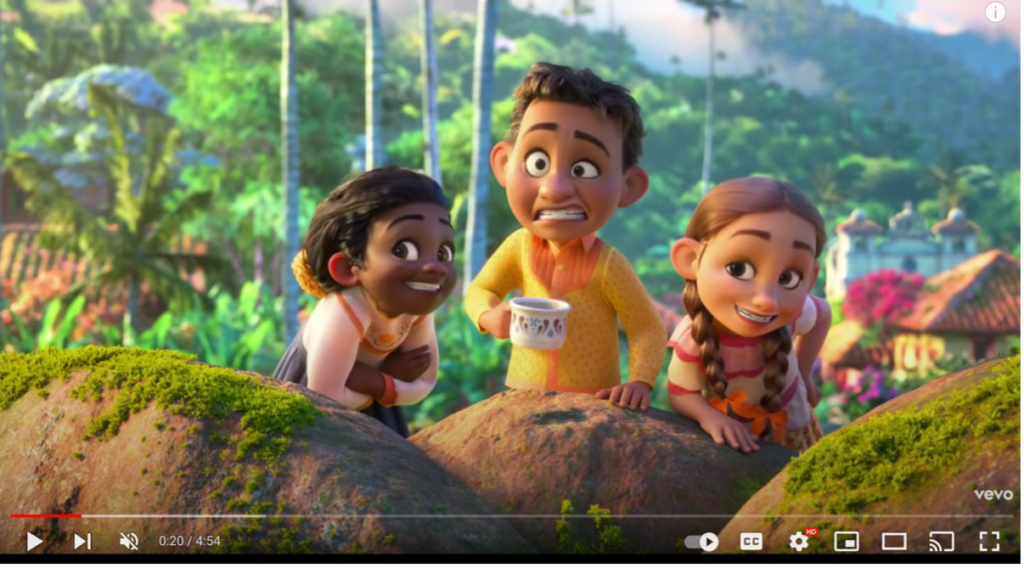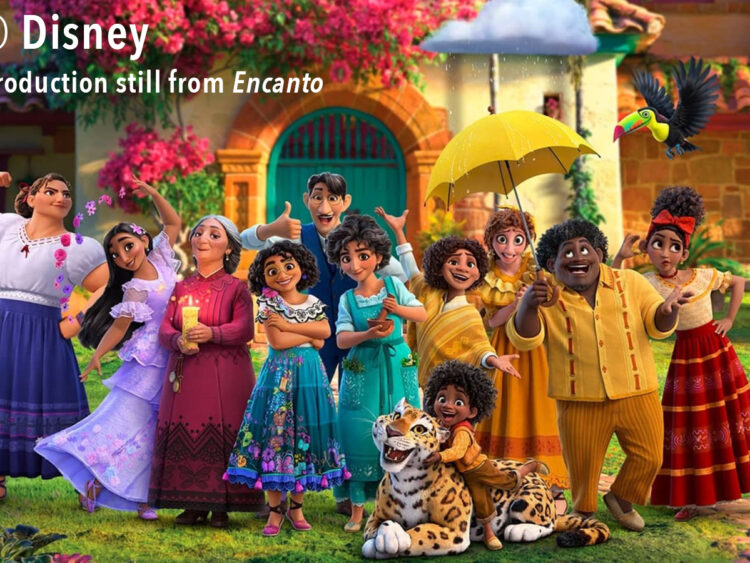The Enchantment of ENCANTO
Early February morning pinks and lavenders outline the clouds in the eastern sky before exposing a tree line, then the frozen garden, and snowshoe paths to the woodshed. My winter eyes are used to a variety of gray, black, and variegated white shadows nuanced on the snow with the occasional dried brown oak leaves. This blush of color melds into a white washed sky when the sun rises.
Perhaps it was this muted seasonal background palette that made the rainbow of colors satiating my retinas even more brilliant as the movie Encanto splashed across the screen. My methodical approach to surviving winter, step by step, hunkering my head down between my shoulders bundled against windchill, was shattered by the energy pouring out over the theater. My sluggish brain began to thaw. Images of house tiles keeping time to the music, children spurting out dual-lingual questions to Mirabel, the lead protagonist, and imaginary jungle birds swooping over the magical village required that I perk up and pay attention.
I literally felt my body release as the music washed over my winter coat, boots, scarf, and mittens. My shoulders relaxed. For the next hour and 49 minutes, I let this fast-paced, bilingual, multicultural, musical depiction of Colombia take away the numerous ills of the world. I left refreshed, smiling, and with “We Don’t Talk About Bruno” stuck in my head.
It wasn’t until I saw it again that I tuned into other levels of the story. Latin literature is renowned for symbolism, a circular, as opposed to linear, story line, and something called magic realism – a writing style brought to life by the Colombian Nobel Prize winning writer Gabriel Garcia Marquez. (Think: Love in a Time of Cholera and One Hundred Years of Solitude)
As much as we could dissect this film for coming full circle and presenting all levels of magical realism, the reviews following Encanto’s arrival in November were much more personal. There was the hypothesis of “Intergenerational Trauma” referring to Abuela Alma’s being driven from her home village by unidentified attackers, her husband’s murder, and her flight as a refugee with tiny triplets. How had that affected all her descendants? Did her fears of violent loss and separation carry into the development of the personages of the Familia Madrigal?
Going beyond her family, expand out from that tragic moment at the river, to the rivers separating Guatemala and Mexico or Mexico and the United States. What we see in a few seconds on screen is unfolding currently with countries experiencing violence and family separation. This is not the usual stuff of Disney cartoons, but past history and current events. What of the families waiting now on “the other side” of the river, living past and producing future intergenerational traumas?

On a positive note, Encanto is being cited for the common exclamation, “I can see myself in that person,” referring to the multitude of racial mixtures evident in the film. Taking the close look at Spain coming to the Americas with their Moorish, Jewish, and even Irish blood evident in 1492, combined with myriad native civilization inhabiting the “New World” with which they mixed, often violently, followed by African slaves; the Latino bloodlines cover the human spectrum. That “everyone” can see themselves in this movie is an admirable achievement.
Bruno, the one we don’t talk about, symbolizes the indigenous in this family of multiracial backgrounds. Bruno is mystical and clairvoyant. He holds a ritual, invoking the four directions, predicting family events – an ability that is feared and shunned until his gift is understood. We discover that each gift that seems to define an individual also brings responsibility and certain confinements.
A must-mention goes to the musical genius of Germaine Franco (Mexican-American) and Lin-Manuel Miranda (Puerto Rican descent), creators of this sound track shooting to the top of the charts. Perhaps the days of ignoring talent outside the status quo are over. One can hope.
Perhaps, like me, you are blown away by the artistry of animation. How can they make a hug look so real, emotions radiate off of cartoon faces, and actor’s voices fit into lip-synced moving mouths?
Perhaps you are wondering what your gift is and how to balance the responsibility with being true to a wholistic personality. How can you manifest your piece/peace on earth?
Or, perhaps, you just need the rainbow of colors to explode with every shade of purple, yellow, and pink ever imagined to fill a winter’s day.
Encanto – Enchanting.
Here is an 8 minute video that reviews of each (latino) actor and their character, showing the dubbing process with comments about COVID work from various countries:


Encanto looks gorgeous…! I will try to see it..Thanks for getting the word out! Abrazos Jan!!!